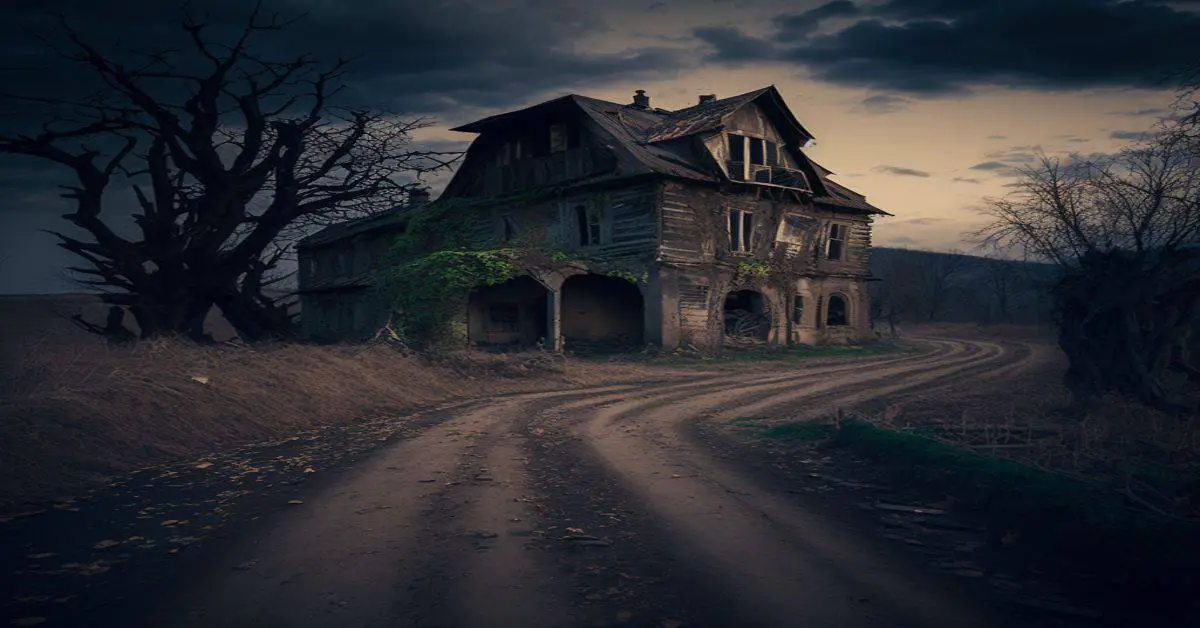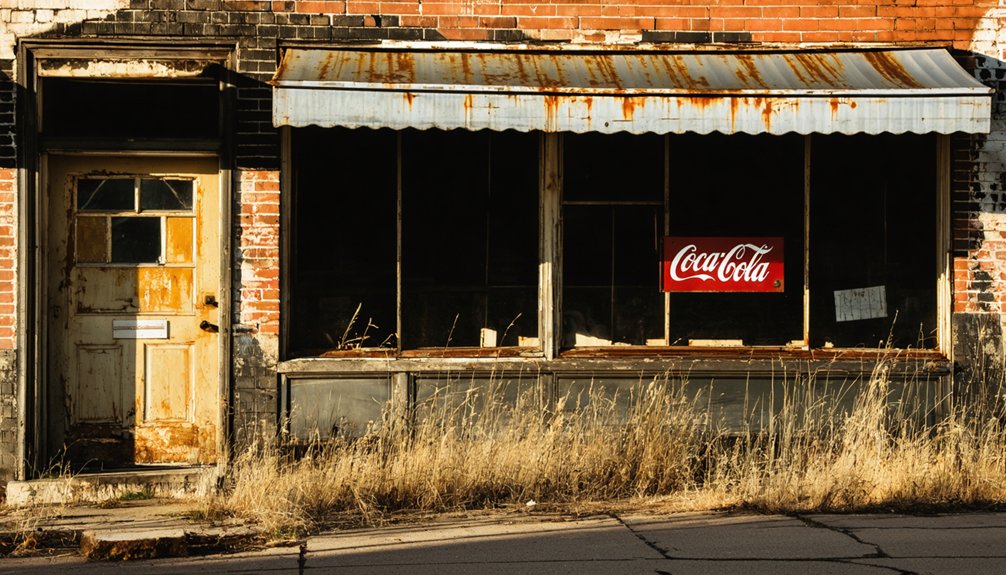You’ll discover Santa Fe Park nestled on an island in Illinois’ Des Plaines River, where a vibrant railroad community thrived from 1896 until after World War II. The Chicago, Rock Island and Pacific Railroad once transported visitors to this entertainment complex featuring grandstands, a dance hall, and beer garden. Today, you can explore the abandoned structures, including a prominent stone chimney, while guided tours reveal tales of public executions and ghostly encounters that shaped this mysterious ghost town.
Key Takeaways
- Santa Fe Park was established in 1896 as an entertainment complex with grandstands, dance hall, and beer garden in Willow Springs, Illinois.
- The park’s success was directly tied to the Chicago, Rock Island and Pacific Railroad, which transported visitors to the location.
- Local residents invested $40,000 for railway development, showing the community’s commitment to the park’s railroad-centered growth.
- The site declined after World War II when automobile travel became more popular, leading to decreased railroad usage.
- Today, abandoned structures and a prominent stone chimney remain as evidence of the former entertainment destination’s historical significance.
History of Santa Fe Park’s Railroad Heritage
While Frederick Tiedt established Santa Fe Park in 1896 as a picnic grove and race track in Willow Springs, Illinois, it was the site’s proximity to the Chicago, Rock Island and Pacific Railroad that shaped its early identity and growth.
The railroad significance became evident as trains transported spectators to the entertainment complex, which featured grandstands, a dance hall, beer garden, and bowling alley. Similar to another historic Santa Fe site, residents contributed $40,000 for right-of-way to support rail development and community growth. After a devastating tornado in the late 1920s, the park’s activities were temporarily halted.
The transportation evolution of Santa Fe Park mirrored the region’s dependence on rail networks. As the Santa Fe Railroad connected Chicago to outlying communities, the park transformed from a local gathering spot into a regional destination.
This essential railroad infrastructure supported the venue’s success through the early 20th century, until post-World War II when automobile travel began replacing rail as the primary means of reaching the grounds.
Location and Natural Surroundings
Located on an island within the Des Plaines River, Santa Fe Park Ghost Town stands as a tribute to Illinois’s bygone era. You’ll find it at 40.9238° N, -89.4938° W in rural Peoria County, where Route 83 provides the nearest access point.
The site’s unique geographic features include flat prairie terrain and eroding riverbanks, creating a natural boundary that’s kept the area isolated since its abandonment in the 1940s. The area was developed into a modern park when the Santa Fe Rail Corporation donated the land. The park now offers scenic overlooks that showcase the natural beauty of the region.
The surrounding landscape serves as a wildlife habitat, where native Illinois species thrive among prairie grasses and riparian vegetation. Deer and various birds make their home in this mix of open fields and scattered trees.
If you’re planning to explore this remote location, you’ll need a 4WD vehicle, and it’s best to visit during spring or fall when temperatures are moderate and river conditions are most stable.
Remnants and Structural Landmarks
The remnants of Santa Fe Park Ghost Town tell a fragmented story of rural Illinois life.
Similar to Santa Fe Plaza, these abandoned structures scattered throughout the area represent architectural significance diminished by time and weather. While the buildings’ specific details remain scarce in historical records, they represent typical rural Illinois construction of their era.
A large stone chimney remains as one of the most prominent features of the site.
Today, you’ll encounter overgrown ruins and debris, presenting both restoration challenges and safety concerns for explorers.
The deteriorating landmarks, once homes and businesses, now serve as silent witnesses to the town’s past. These structures hold archaeological value, offering clues about daily life in this former community.
While preservation efforts would require substantial resources, the site maintains potential for careful exploration and historical study, particularly for those interested in ghost town tourism and architectural history.
The Town’s Decline and Abandonment
As railroad operations shifted away from Santa Fe Park in the mid-20th century, this once-bustling Illinois town began its inevitable decline.
Multiple economic factors converged to seal the town’s fate: the loss of essential railroad shipping services, closure of the post office, and the disappearance of agriculture-related businesses that once thrived along the tracks. The pattern mirrored that of other railroad towns like Buda, where the Chicago Burlington and Quincy Railroad once drove prosperity.
The town’s location on an island in the Des Plaines River, once an advantage for rail transport, became a liability as flooding risks increased and modern road networks bypassed the area. Much like the Elgin Ferry Disaster that transformed another Illinois town’s destiny, Santa Fe Park’s relationship with waterways proved fateful.
Migration trends show younger residents relocating to larger towns with better amenities and job prospects.
Visitor Experience and Safety Guidelines
While exploring Santa Fe Park’s haunting remnants, visitors begin guided walking tours that traverse roughly one mile of the abandoned townsite.
You’ll encounter tales of violent uprisings, public executions, and ghostly sightings of Spanish soldiers that still patrol the historic streets. Tour guides blend Native American history with Spanish colonial lore while leading you through publicly accessible areas. Tours often receive 5.0 out of 5 bubbles from satisfied visitors.
For tour preparation, wear comfortable walking shoes to navigate uneven cobblestone streets. Bring a flashlight since visibility is limited during night tours. Knowledgeable tour guides share engaging stories that bring nearly 400 years of history to life.
You’ll want to stay with your group as you explore the paranormal hotspots, including haunted hotels and museums housing mysterious artifacts.
Remember to respect private property boundaries and historic structures while photographing your supernatural adventure through this forgotten town’s darkened pathways.
Frequently Asked Questions
Are There Any Documented Paranormal Activities or Ghost Sightings in Santa Fe Park?
You won’t find any documented ghost encounters or spectral phenomena here. Despite its ghost town status, historical records don’t mention any paranormal activity along the abandoned railroad tracks or building foundations.
What Was the Peak Population of Santa Fe Park During Its Heyday?
Precise population peaks prove perplexing, as you won’t find documented numbers during community events or the town’s prime. Population decline occurred gradually, but historical records don’t reveal exact figures from its heyday.
Were There Any Notable Crimes or Incidents in Santa Fe Park’s History?
You won’t find any notorious incidents or unsolved mysteries in the historical records. The area’s challenges came mainly from natural hazards, particularly flooding along the Des Plaines River.
Did Any Famous Historical Figures Ever Visit or Stay in Santa Fe Park?
You won’t find records of any famous visitors to this railroad stop. Historical significance stems from its basic infrastructure, with no documented stays by notable figures before its 1940s abandonment.
What Businesses and Services Operated in Santa Fe Park Before Abandonment?
You’ll find records show basic local businesses and community services operated there, including farming activities, small-scale industries, and essential facilities like schools, though specific details remain largely unknown to historians.
References
- https://usghostadventures.com/americas-most-haunted-trending/ghost-towns-to-visit-on-your-summer-road-trip-along-route-66/
- https://www.youtube.com/watch?v=qRVelHci92k
- https://www.youtube.com/watch?v=fy3yJDBA5nI
- https://drloihjournal.blogspot.com/2022/09/lost-towns-of-illinois-appleton-illinois.html
- https://www.frrandp.com/p/ghost-towns-map.html
- https://www.ghosttowns.com/states/il/santafepark.html
- https://en.wikipedia.org/wiki/List_of_ghost_towns_in_Illinois
- https://www.gosanangelo.com/story/news/2020/01/22/history-san-angelo-parks-began-santa-fe-railroad/4470653002/
- http://www.kalracing.com/autoracing/santa_fe_speedway_history.htm
- https://en.wikipedia.org/wiki/Atchison



